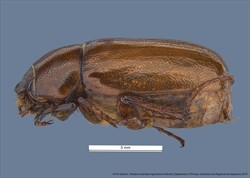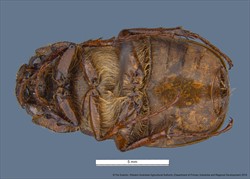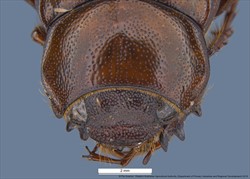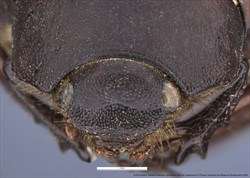Sub family: Melolonthinae / Tribe: Melolonthini / Genus: Holotrichia
Fact Sheet
Holotrichia Hope, 1837
Large cylindrical beetles, body length 15-30mm. Body colouration ranging from yellow/tan, brown to dark brown. Antennae 10 segmented, with a 3 segmented club that is enlarged in males. Clypeus usually broadly rounded, sometimes emarginate. Labrum located under clypeus, clearly separated and deeply incised medially, commonly with medially directed setae on each lobe. Pronotal lateral margins usually serrate. Pronotum lacking membraneous anterior margin. Elytra punctate. Foretibia tridentate. Metatibia with 2 apical spurs an a transverse ridge near its mid point. Mesometasternal process is absent. Metasternum setose. Propygidium with lateral sutures. Tarsal claws non-cleft, with a medial tooth.
Many species posess stridulatory ridges along the elytral lateral edge (epipleura).
Larvae feed on roots, and can cause sgnificant damage to peanut, potato, sugarcane, maize and peas among others. Adults can also feed on foliage, causing damage to a wide range of fruit and orchard trees. Some adult beetles may or may not be attracted to lights at night.
The genus Holotrichia is absent from Australia. It is primarily Oriental in distribution, found across India, and through Asia into Japan.
H. bipunctata has spread outside its native range (Phillipines) to Guam, thought to be from movement of the US military.
PaDIL species page for Holotrichia kiotoensis: http://www.padil.gov.au/pests-and-diseases/pest/main/135632
Holotrichia bipunctata species page (Hawaiian Scarab Website): http://idtools.org/id/beetles/scarab/factsheet.php?name=15191
Dunlap, J.B., Jameson, M.L., Engasser, E.L., Skelley, P.E., Redford, A.J. 2015. Scarab and Stag Beetles of Hawaii and the Pacific. USDA APHIS Identification Technology Program (ITP). Fort Collins, CO. http://idtools.org/id/beetles/scarab/
Matsumoto, T. 2010. Four new species of the Holotrichia constricta group (Scarabaeidae, Melolonthinae, Melolonthini) from the Philippines. Elytra, Tokyo, 38(1): 43-52







